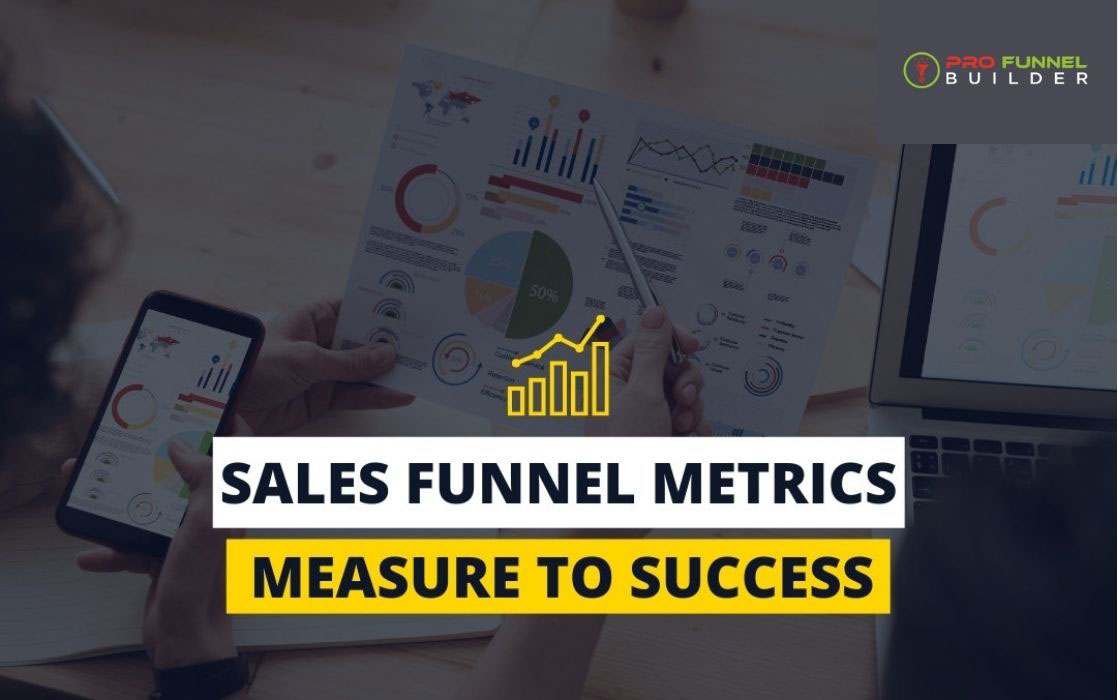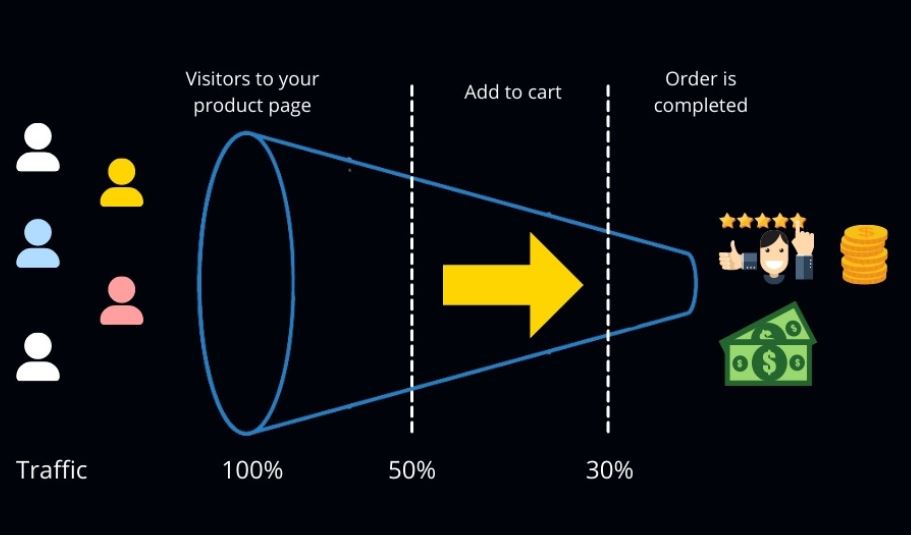The 4 Critical Sales Funnel Metrics You Should Follow

Light on the magic scheme to trade everything you want to. Are you an entrepreneur or merchant? If you are, then you can’t avoid the sales funnel data. These data showcase your number one product. And also give you the rational plan of action of your business.
We will give you a complete overview of the sales funnel and Sales Funnel Metrics. So, if you don’t know anything about these topics, you will get all your answers after reading this article.
What Is the Sales Funnel Metrics?
Sales funnel metrics is a theory that calculates consumer retailing metrics. You might have a great product. But you can’t be sure that the buyer will buy your product. For that reason, you need a specific marketing strategy.

The sales funnel has four consequential stages where your valuable customer has the first page. After that, turn on the perspective and the product pr, the number of transformations becoming buyers. Eventually, audience purchase costs will reduce.
Most people have an interest in every product. But a particular audience put the money to buy it. So, to go down the sales phase, you have to keep a considerable consumer.
And sometimes, you have to pick a larger audience and leave the smaller ones. If you can do it, then you will achieve a good concept that is more effective and adaptable.
To enhance your business, you can study sales funnel metrics. If you do so, that will help you to indicate the problem. Which you faced and you can make a perfect plan to improve your sales.
Four Key Online Metrics for Sales Funnel
A sales funnel a journey to a purchaser from seeking to a buyer. This whole process has four stages, which focuses on the potentiality of the business.
1. The Number of Accesses
As a consumer, you always need to get an exact quantity. Detailed numbers in each product can help you. For that reason, you could find our power and fault also.
- Traffic: Traffic is an indicator of your plan. And they will help you to see how constructive your idea is. In social media, you can run your product ads. And you can also see who your audience is. If you see your targeted audience and the viewers don’t match. Then you have to change your audience categories. These funnel metrics will give you the perfect plan. From the campaign, you can inspect your business strategy, which will lead you to a complete marketing proposal.
- Return Traffic: Eye-catching ads can divert more people. But in the end, people need their desired product. At this time, you have to be intelligent. Firstly, you have to give accurate information about your product. Secondly, you must put all the information one by one. So that the viewer can easily see all the details, and thirdly if you do all the work beautifully, your traffic will give a good impression. But if you fail to do so, you can’t manage the audience. They will leave eventually if they don’t get basic information related to the product. So before making an ad, you must survey what your viewer wants. Navigation popup bars and chatbots will help you to find out the result.
- Measure Leads Generated: If you can analyse the number of viewers and the audience, that will not back. It is time to make those valuable viewers turn customers to your product. Conversation can help you to engage people. And if you can find out your audience, you can send an email. Where you have to showcase your marketing strategy and your promotional campaign, tools will help you check out your audience behaviour and purchase plan.
- Measure Sales Opportunities: In this segment, if you get the consumer who knows your business and products, it will help you to make an exact plan. While making a campaign, you must check marketing and sales strategy. Without these steps, you may have a large viewer but can’t sell the product.
2. Conversion Rate
A professional cycle that can determine the research and make specific reports on conversion rates will help your business. To do these activities, you need enough time. Because measurement and survey need time to do specifically, for that reason, you may do a lot of campaigns.
- Overall Conversion Rates: The number of people who visit your page and the number of people who buy your product will determine the overall conversion rate. If you see 2000 traffic and 1000 purchases from new users, your conversion rate is 50 per cent. If you get a higher number, that means your sale is well. But if the sale is below 50%, you must change your plan of action like prices or images.
- In-Process Conversion Rate: This section will measure how many buyers convert from a lead to a customer. You can identify which plan of action is working smoothly from this conversion rate. Inversely, you can know what is terrible and what you have to improve.
3. Average Sales
Profit shows how successful your business is. Progress needs time. You can make ads and do campaigns. But without good results, all your effort will go into vain. If we give you an example, your vision will be clear. A company deals with products, but a business deals with volumes or return traffic.
- Categorize Sales Funnels by Potential Customers: Customers can find you from any source because they search online or on social platforms. That’s why you must check their group and where they come from. You can identify this through a survey. Your actual customers will be those who fill up all the information throughout the survey. And you can focus on those and give them a token of love to stay with you.
- How to Calculate Investment Fee per Lead: The money you put into ads is the cost of your valuable customers. To find out the benefit, you have to divide the money you spent by the number of people you reached. Your opportunity price is a consumer who sees your ads or campaign and buys your product when you spend money. And the result depends on everything from making ads to selling products. How much you consume on each sale depends on the price per sale. Here the value depends on opportunity price, cost of packaging, shipping, etc. If you have excellent service, your consumer will be happy to take your service. And they may buy or refer others to purchase the product. That’s how you earn revenue from each customer.
- Opportunity, the Value from Potential Customers: If you want to calculate the return value from each lead, you have to evaluate the cost of the campaigns. This process needs to apply for a particular phase to get the revenue. You get your total revenue from that total, minus the primary fees, promotion, and management fees. After that, divide the result that you get earlier with the number of your valuable consumers. Lastly, if the number is positive, you are in profit. Which means your business is on the final track.
- Sales Speed Is the Key to Success: There are many ways to find out the sales speed. From your sales funnel, you can get your rate of bargain estimate. This rate depends on the median cost of an order, the number of pick-up products, and the sales circle area. This can be used for weekly or monthly revenue. After that, you could choose your strategy.
4. Duration Of the Sales Funnel Process
The most important metric you need to look forward to upgrading your conversions and sales is the period of your sales funnel.
At first, people take more time to purchase anything. But now the time is getting shorter. If your consumers buy products within a few minutes, that means your strategy is great. You could successfully divert your consumer to purchase your product.
Always see the buyer’s track record of how much time they spend buying a product. After that, you can change your plan according to their needs.
How To Use Sales Funnel Metrics?
To see your business growth, sales funnel metrics are the best tools. You can make a proper business plan and marketing strategy using these tools.
As a result, you may find it difficult to see the figures of the sales funnel. However, you must investigate your campaign to make a full report. From there, you will find out your faults and strengths also.
Good sales funnel metrics give you the hope that you are in an excellent position to attract consumers. And that time is good enough to make your traffic convert to a buyer.
Sometimes you find a shortfall in the sales process. But if your sales team can fix that point and make a solution to overcome it.
Sales funnel metrics must be used as an opportunity for your business. In addition, you have to take advantage to convince your consumer to buy your product.
Finding consumer information may be difficult. But making good relations with them will help you find the information about them, which will help you make a promotional campaign.
Critical Sales Funnel Metrics FAQs
Many people find that sales funnel metrics are complicated. That’s why you hesitate to use these in your business. So, you can see the questions, and then you feel comfortable using them productively.
What Is the Best Metric to Measure the Effectiveness of A Sales Funnel?
To measure your sales growth, total sales are the best metrics. This funnel identifies your gross sales measurement. E-commerce and traditional business methods are different. So, the funnel result may not match.
The sales team can also always make the best idea to use these funnels. And they lead the elevated profit with the smallest investment.
Can Indicators Be Used in Different Stages of The Funnel?
Whenever you make a campaign, you will measure each part of that campaign. But you can’t use that result for the whole procedure.
To overview your business development, there are four indexes:
- Cost per conversion
- Customer’s lifetime value
- Conversion rate
- Conversion rate per funnel
How to Calculate the Overall Conversion Rate?
Overall conversion rate depends on customer visits; sales qualified leads, interested and engaged consumers, and the actual buyer.
Sales funnel metrics examples:
- Suppose you have traffic of 5000 people. But from there 2000 people are curious about your products. Which is -40%. Then the number of people who will remain with you is 1000 (that is 50%) and the number of people who may buy your product is 850(equivalent to 85%)
- And at last, you will get the number of people who send money is 520 people (which means 80%). Now calculate the overall conversion rate and you get the result: 40%×50%×85%×80*= 10.4%
- You can also calculate it another way. Here you have to divide the number of people who buy with the total number of traffic and multiply it by 100. Like:( 520÷5000) ×100=10.4%
Conclusion
Sales funnel metrics are essential to optimise campaigns, ads, and their activities. Without these, you can’t make progress and can’t calculate the whole procedure.
Therefore, using these funnels may be different for different business models. But you have to analyse every piece of data to respond to the situation, which will lead you to the success story of your business.
